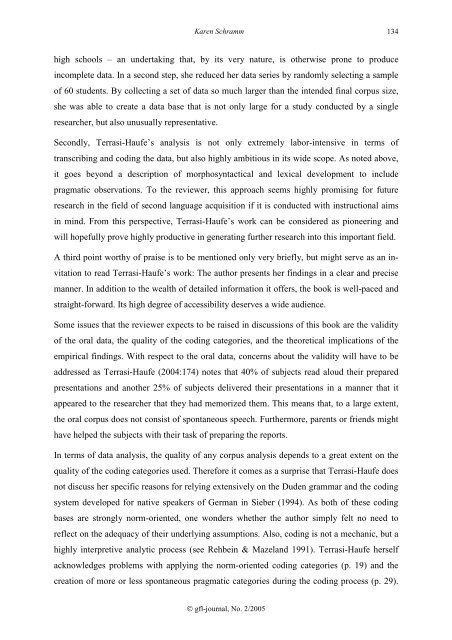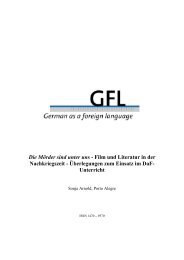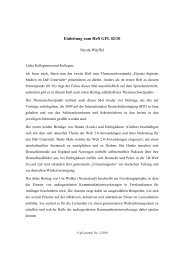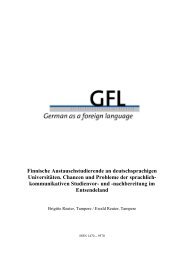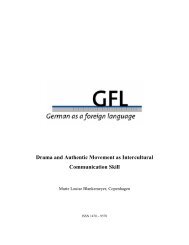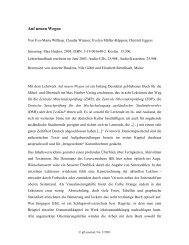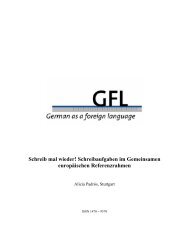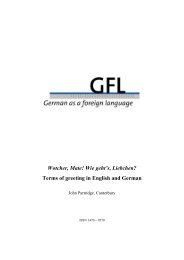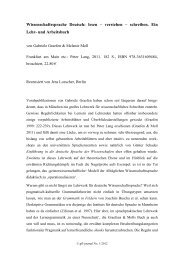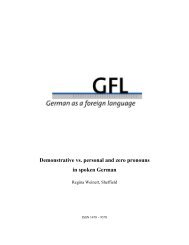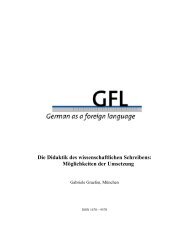Der Schulerwerb von Deutsch als Fremdsprache - GFL-Journal
Der Schulerwerb von Deutsch als Fremdsprache - GFL-Journal
Der Schulerwerb von Deutsch als Fremdsprache - GFL-Journal
Create successful ePaper yourself
Turn your PDF publications into a flip-book with our unique Google optimized e-Paper software.
Karen Schramm<br />
134<br />
high schools – an undertaking that, by its very nature, is otherwise prone to produce<br />
incomplete data. In a second step, she reduced her data series by randomly selecting a sample<br />
of 60 students. By collecting a set of data so much larger than the intended final corpus size,<br />
she was able to create a data base that is not only large for a study conducted by a single<br />
researcher, but <strong>als</strong>o unusually representative.<br />
Secondly, Terrasi-Haufe’s analysis is not only extremely labor-intensive in terms of<br />
transcribing and coding the data, but <strong>als</strong>o highly ambitious in its wide scope. As noted above,<br />
it goes beyond a description of morphosyntactical and lexical development to include<br />
pragmatic observations. To the reviewer, this approach seems highly promising for future<br />
research in the field of second language acquisition if it is conducted with instructional aims<br />
in mind. From this perspective, Terrasi-Haufe’s work can be considered as pioneering and<br />
will hopefully prove highly productive in generating further research into this important field.<br />
A third point worthy of praise is to be mentioned only very briefly, but might serve as an invitation<br />
to read Terrasi-Haufe’s work: The author presents her findings in a clear and precise<br />
manner. In addition to the wealth of detailed information it offers, the book is well-paced and<br />
straight-forward. Its high degree of accessibility deserves a wide audience.<br />
Some issues that the reviewer expects to be raised in discussions of this book are the validity<br />
of the oral data, the quality of the coding categories, and the theoretical implications of the<br />
empirical findings. With respect to the oral data, concerns about the validity will have to be<br />
addressed as Terrasi-Haufe (2004:174) notes that 40% of subjects read aloud their prepared<br />
presentations and another 25% of subjects delivered their presentations in a manner that it<br />
appeared to the researcher that they had memorized them. This means that, to a large extent,<br />
the oral corpus does not consist of spontaneous speech. Furthermore, parents or friends might<br />
have helped the subjects with their task of preparing the reports.<br />
In terms of data analysis, the quality of any corpus analysis depends to a great extent on the<br />
quality of the coding categories used. Therefore it comes as a surprise that Terrasi-Haufe does<br />
not discuss her specific reasons for relying extensively on the Duden grammar and the coding<br />
system developed for native speakers of German in Sieber (1994). As both of these coding<br />
bases are strongly norm-oriented, one wonders whether the author simply felt no need to<br />
reflect on the adequacy of their underlying assumptions. Also, coding is not a mechanic, but a<br />
highly interpretive analytic process (see Rehbein & Mazeland 1991). Terrasi-Haufe herself<br />
acknowledges problems with applying the norm-oriented coding categories (p. 19) and the<br />
creation of more or less spontaneous pragmatic categories during the coding process (p. 29).<br />
© gfl-journal, No. 2/2005


